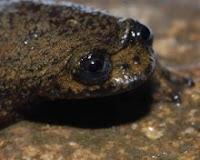The tadpoles of American Toads (Bufo/Anaxyrus americanus) and Fowler’s Toads (B. woodhousei fowleri), and of related US natives, are frequently collected by herpers young and old and taken home to raise. They usually prove quite hardy, and, even on nutrient-poor diets (i.e. lettuce), transform into tiny toadlets within a few weeks.
Toad Maladies
Young toads often prove difficult to raise however, and each year I receive questions concerning the same 2 problems – bloating 
Nutritional Deficiencies
I’ve come to believe that 2 distinct problems are at work. Difficulty in using the rear legs is probably linked to deficiency in calcium or another nutrient, but efforts to reverse it, at least in small toads, have proven unsuccessful.
Using supplements on the food given newly  transformed toads helps, but we really do not know what most species, especially North American natives, actually require.
transformed toads helps, but we really do not know what most species, especially North American natives, actually require.
Tadpole nutrition is another area that needs investigation. Poorly nourished tadpoles may transform, but then die several weeks later…I’ve had this happen on a number of occasions over the years, with several species, even the relatively indestructible African clawed frog (Xenopus laevis).
Bacterial Infection
Bloating is usually a byproduct of a bacterial infection, and may be connected to nutrition. Toads already weakened by a nutritional deficiency may be more likely to become infected with bacteria that healthier clutch mates fight off – hence both symptoms in 1 toad. This is based mainly on anecdotal evidence, but does seem to happen time and time again, and with several species.
Natural Mortality
Another point to bear in mind is that, among species that lay huge clutches, a great many tadpoles will not survive even under the best of circumstances. Some turtles lay infertile eggs, apparently to satiate predators and take attention away from viable ones – I have no hard evidence, but I would not be surprised to learn that weaker tadpoles serve a similar function.
Feeding Tadpoles and Young Toads
Most native toad tadpoles are omnivorous. Try to provide them with as much variety as possible, and bear in mind that, in large groups, smaller, weaker individuals are easily out-competed at feeding time. I’ve had good luck raising tadpoles on a diet comprised of tropical fish food flakes, algae tablets and kale pre-soaked in hot water (this breaks down thick cell walls). Metamorphs (newly transformed toads) consume scores of species of leaf litter invertebrates in the wild, complicating our job in raising them. In addition to tiny frog standards such as fruit flies, springtails and pinhead crickets, you might try collecting tiny invertebrates as toad food (please see article below).
Further Reading
Please see my article Leaf Litter Invertebrates for information on collecting live food for tiny amphibian pets.
Haswell’s Frog tadpole image referenced from wikipedia and originally posted by LiquidGhoul
 That Reptile Blog – Reptile, Amphibian and Exotic Pet Care and Information
That Reptile Blog – Reptile, Amphibian and Exotic Pet Care and Information

